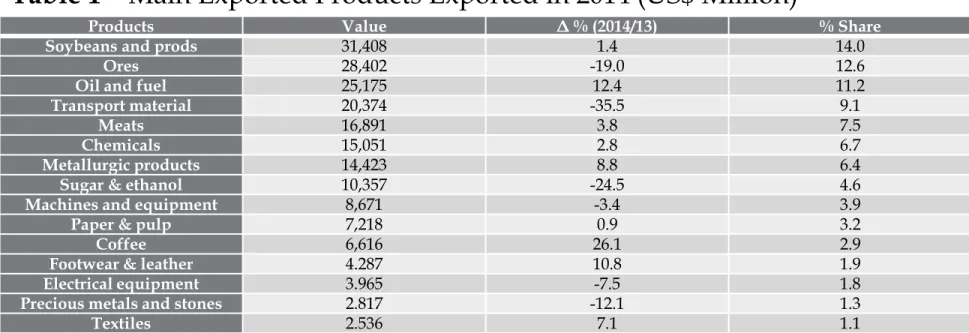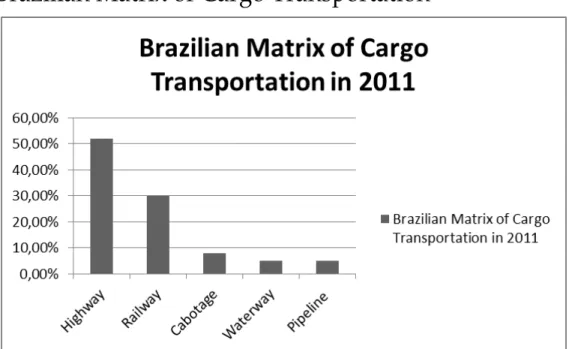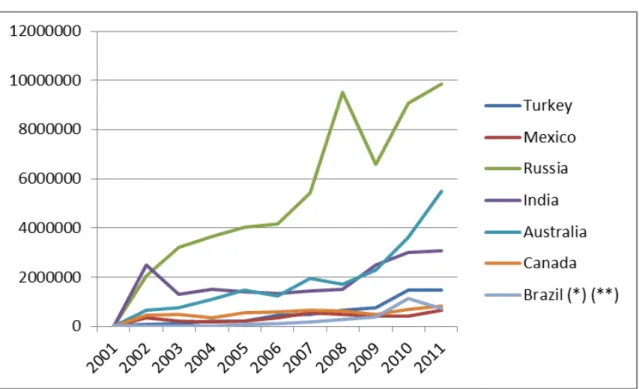The 2012 Regulatory Reform in the
Brazilian Railway Sector and the
public policy cycle
November 2015
Patrícia SampaioResearch Center on Law and Economics –CPDE FGV Law SchoolMariam Daychoum
The public policy cycle
Figura 1–Ciclo de Políticas PúblicasProblem, agenda, alternatives
1. Diagnosis
Problems and Goals
Overview of the Rail Sector and its
role for Brazilian growth
Railways are a more efficient way to transport huge volumes
of freight through long distances when compared to roads
Brazilian GDP has a great dependence on primary
commodities exportations; this cargo is captive of railways
Table 1 – Main Exported Products Exported in 2014 (US$ Million)
Products Value Δ % (2014/13) % Share Soybeans and prods 31,408 1.4 14.0
Ores 28,402 -19.0 12.6
Oil and fuel 25,175 12.4 11.2
Transport material 20,374 -35.5 9.1
Meats 16,891 3.8 7.5
Chemicals 15,051 2.8 6.7
Metallurgic products 14,423 8.8 6.4
Sugar & ethanol 10,357 -24.5 4.6
Machines and equipment 8,671 -3.4 3.9
Paper & pulp 7,218 0.9 3.2
Coffee 6,616 26.1 2.9
Footwear & leather 4.287 10.8 1.9
Electrical equipment 3.965 -7.5 1.8
Precious metals and stones 2.817 -12.1 1.3
Overview of the Rail Sector and its
role for Brazilian growth
May of 2015
CPDE 5
Freight services and infrastructure supply are important variables
when it comes to assessing the
country’s
competitiveness in a
global economy. And Brazil is not well positioned...
According to the Logistics Performance Index – LPI 2014 (World Bank),
Brasil ranks at the 65th position among 160 countries (in 2012, it
ranked 45th among 155 countries). Considering the general quality of
infrastructure, the fall is even greater: whereas in 2012 it ranked at
46th, in 2014 it dropped to 54th => deterioration
According to the Global Competitiveness Report 2014 – 2015 (World
Economic Forum), Brazil ranked 57th among 144 countries, but fell to
Overview of the Rail Sector and its
role for Brazilian growth
Even though railroads are important due to Brazilian exportation
characteristics, as well as territory dimensions, to date the railroad
system is quite poor.
Graphic 1 - Brazilian Matrix of Cargo Transportation
Overview of the Rail Sector and its
role for the Brazilian growth
May of 2015
CPDE 7
Besides the unbalanced Matrix of Cargo Transportation, Brazil has a
low network density:
3.9m per km²
.
Source:STATISTA (2015)
Country Rail Network Density
Germany 117.35m per km²
Poland 71.36m per km²
Japan 69.95m per km²
United Kingdom 67.54m per km²
United States 23.04m per km²
India 23.04m per km²
South Africa 17.12m per km²
Pakistan 9.79m per km²
Mexico 8.92m per km²
China 8.11m per km²
Kazakhstan 5.53m per km²
Overview of the Rail Sector and its
role for Brazilian growth
It also has low rates of investment...
Graphic 2- Investments in rail infrastructure in US$ (billion)
Sources:OECD Index; (*) Brazilian Ministry of Transportation (R$)
Overview of the Rail Sector and its
role for the Brazilian growth
May of 2015
CPDE 9
And productivity...
Graphic 3 - Railways, goods transported (million ton-km)
The two Brazilian patterns of Rails
Pivatization and Sectorial Regulation
In the 90s Brazil experienced a privatization programm under which
the existing railways were divided in six different geographic areas,
plus the railway of São Paulo state, and concessioned under vertically
integrated arrangements
The proccess began in 1992 with the inclusion of
the Federal Railway Network (RFFSA) in the PND
All the consortiums that owned concessions experienced the
presence of a commodity (agricultural or mineral) producer
The two Brazilian patterns of Rail
Pivatization and Sectorial Regulation
May of 2015
CPDE 11
Privatization process succeeded in increasing productivity....
Graphic 4 - Brazilian Railroad Productivity
The two Brazilian patterns of Rail
Pivatization and Sectorial Regulation
.... and significantly reducing accidents.
Graphic 4 - Brazilian Railroad Accident Rates
CPDE 13
Nonetheless, there was little
increase in the network in terms of
building new railroads, as well as in
2. Alternatives and policy
decision
3.
Different
possible
regulatory
designs
CPDE 15
Share
of
infrastructure
among
vertically-integrated
concessionaires => grant of access
Unbundling infrastructure and services
Accounting separation; Legal entity separation;
4. Policy decision: The 2012 Reform
National Logistics Investment Program launches a new concession model:
Segregating activities within the sector
Separating investment in infrastructure from service provision
The whole capacity of the new railroads would be purchased by VALEC, a federal State-owned company, and resold in the market
Institutional Actors and their Roles in
the 2012 Arrangement
May of 2015
CPDE 17
National Agency for Terrestrial Transportation (ANTT);
EPL (State-owned company);
VALEC (State-owned company);
would act as a network manager; it would acquire from infrastructure concessionaires their whole network capacity of transportation and auction such capacity to:
(i) Customers willing to transport their own cargo; (ii) Independent Rail Operators (OFI);
(iii) Already-existing rail concessionaires.
The company would then work as a “manager marketplace”, in which providers and customers would meet through VALEC (PINHEIRO, 2014).
Policy decision without sufficient evaluation of possibilities?
The Federal Court of Accounts 2012 challenged the reform on the grounds of (i) Lack of legal basis
(ii) Lack of technical studies (or at least they were not available) (iii) Lack of regulatory impact assessment
(iv) Lack of discussion with stakeholders of the unique model
Other issues:
Fiscal constraint
Business risk fully attributed to the government demand capacity
purchase
Cohexistence of two different concession models: risk of bottlenecks and
Results
• Between 2012 and 2015 the government did not succeed in launching
even 1 public procurement process
• Fiscal Constraint
• In June 2015 the government stepped back to a vertically-integrated
model
• The final question: Will it be successful?






